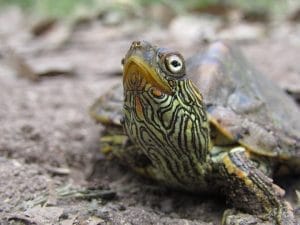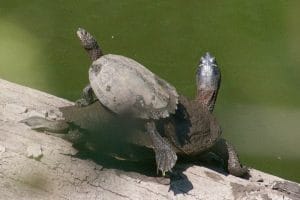Graptemys pulchra (Alabama map turtle)
Home > Turtle Database > Graptemys pulchra (Alabama map turtle)

The Alabama map turtle (Graptemys pulchra) is a freshwater turtle species native to the southeastern United States. Known for the intricate map-like markings on its carapace, this turtle is a distinctive member of the family Emydidae.
Native Turtle Species Map – Find Turtles by Region
Scientific Classification
- Kingdom: Animalia
- Phylum: Chordata
- Class: Reptilia
- Order: Testudines
- Family: Emydidae
- Genus: Graptemys
- Species: Graptemys pulchra
Common Names
- Alabama Map Turtle
- Beautiful Map Turtle
This Hilarious Turtle Book Might Know Your Pet Better Than You Do
Let’s be real—most turtle care guides feel like reading a textbook written by a sleep-deprived zookeeper.
This one’s not that.
Told from the snarky point of view of a grumpy, judgmental turtle, 21 Turtle Truths You’ll Never Read in a Care Guide is packed with sarcasm, sass, and surprisingly useful insights.
And hey—you don’t have to commit to the whole thing just yet.
Grab 2 free truths from the ebook and get a taste of what your turtle really thinks about your setup, your food choices, and that weird plastic palm tree.
It’s funny, it’s honest, and if you’ve ever owned a turtle who glares at you like you’re the problem—you’ll feel seen.
Identification
Description
The Alabama map turtle has a brown to olive carapace adorned with light-colored, map-like patterns and serrated edges toward the rear. The plastron (underside) is typically light yellow. It possesses a small to moderate-sized head with a pointed snout and distinctive yellow markings behind the eyes.
Sexual Dimorphism
Females are significantly larger than males, with carapace lengths reaching up to 11 inches (28 cm), while males typically grow up to 5 inches (13 cm). Females have broader heads and stronger jaws adapted for crushing mollusk shells, whereas males have longer tails and more pronounced dorsal keels.
Check more turtles from the Graptemys genus
Native Origin and Distribution
Geographical Range
This species is endemic to the Mobile Bay drainage system, inhabiting river systems in Alabama, southeastern Mississippi, and parts of Georgia. Their range includes the Alabama, Tombigbee, and Black Warrior rivers and their tributaries.
Preferred Habitat
Alabama map turtles prefer fast-flowing, large rivers with abundant basking sites like fallen logs and rocks. They are often found in areas with sandy or muddy bottoms and ample aquatic vegetation, which supports their dietary needs.
Behavior
Feeding Habits
These turtles are primarily carnivorous. Females feed predominantly on mollusks such as snails and clams, thanks to their robust jaws. Males and juveniles consume a more varied diet, including insects, small crustaceans, and occasional plant matter.
Predators
Predators of the Alabama map turtle include raccoons, birds of prey, large fish, and alligators. Eggs and hatchlings are particularly vulnerable to predation by mammals and other reptiles.
Reproduction
Breeding Season
Breeding occurs from spring to early summer. Females lay eggs from May to July, depositing multiple clutches per season, each containing 5 to 15 eggs.
Reproductive Method
The species is oviparous. Females lay eggs in nests dug into sandy or soft soil along riverbanks. Incubation lasts about 75 to 85 days, with hatchlings emerging in late summer to early fall.
Conservation
Extinction Status
- IUCN Red List: Near Threatened
Threats
- Habitat Loss: Pollution, dam construction, and river modifications degrade their natural habitats.
- Illegal Collection: Overharvesting for the pet trade reduces wild populations.
- Predation: Increased predation due to human-altered environments.
Conservation Measures
- Legal Protection: Protected under state laws in Alabama and Mississippi.
- Habitat Restoration: Efforts to preserve and restore river habitats.
- Research and Monitoring: Ongoing studies to monitor population trends and health.
Economic Importance
While not a significant economic resource, Alabama map turtles contribute to the ecological health of river systems by controlling mollusk populations. They also have value in the pet trade, although collection from the wild is regulated to prevent population decline.
Interesting Facts
- The name pulchra means “beautiful” in Latin, referring to the turtle’s ornate shell patterns.
- Alabama map turtles are known for their shy nature, often diving into the water at the slightest disturbance.
- They play a crucial role in their ecosystem by influencing the population dynamics of their prey species.

About Author
Muntaseer Rahman started keeping pet turtles back in 2013. He also owns the largest Turtle & Tortoise Facebook community in Bangladesh. These days he is mostly active on Facebook.














